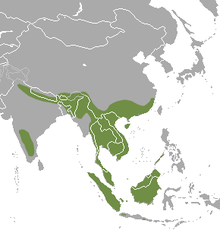Oriental small-clawed otter
| Oriental small-clawed otter | |
|---|---|
 |
|
| Scientific classification | |
| Kingdom: | Animalia |
| Phylum: | Chordata |
| Class: | Mammalia |
| Order: | Carnivora |
| Family: | Mustelidae |
| Subfamily: | Lutrinae |
| Genus: |
Amblonyx Rafinesque, 1832 |
| Species: | A. cinerea |
| Binomial name | |
|
Amblonyx cinerea (Illiger, 1815) |
|
 |
|
| Oriental small-clawed otter range | |
| Synonyms | |
|
Amblonyx cinereus |
|
Amblonyx cinereus
Aonyx cinereus
Aonyx cinerea
The oriental small-clawed otter (Aonyx cinerea syn. Amblonyx cinereus), also known as the Asian small-clawed otter, is the smallest otter species in the world. Its paws are a distinctive feature, its claws not extending beyond the fleshy end pads of its partially webbed fingers and toes. This gives it a high degree of manual dexterity so that it can use its paws to feed on molluscs, crabs and other small aquatic animals.
The oriental small-clawed otter inhabits mangrove swamps and freshwater wetlands in South and Southeast Asia. It lives in extended family groups with only the alpha pair breeding; offspring from previous years help to raise the young. Due to ongoing habitat loss, pollution, and hunting in some areas, it is listed as Vulnerable on the IUCN Red List.
This species was originally described as the only member of the genus Amblonyx, but was transferred to the genus Aonyx after analysis. However, further studies have shown that this species is more closely related to the genus Lutrogale than to Aonyx, which means the genus Amblonyx should be retained. A synonym for the oriental small-clawed otter is Aonyx cinereus.
Oriental small-clawed otters are the smallest extant otter species. The overall length can range from 70 to 100 cm (28 to 39 in), of which about 30 cm (12 in) is the tail. Weight can range from 1 to 5.4 kg (2.2 to 11.9 lb). Its body is slender, streamlined and serpentine, and is flexible enough to allow grooming of almost all the body. Dark, grayish-brown fur covers most of the dorsal surface with a lighter cream coloration on the ventral surface, especially on the face and neck. The fur has relatively short hairs less than 2.5 cm in length, and it is fine, dense and velvety. Otters have two types of fur: long, stout guard hairs and a short, fine undercoat.
...
Wikipedia

